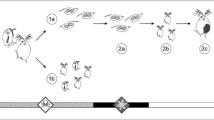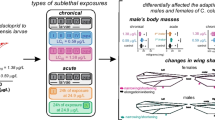Abstract
A few studies reporting the effects of tebufenozide, a non-steroidal ecdysone agonist that mimics natural moulting hormones in chironomids exist in the literature. However, nothing is known about its chronic or multigenerational effects on the reproduction of aquatic insects, although tebufenozide is present in aquatic ecosystems. Here, we investigated the chronic toxicity of tebufenozide in two successive generations of Chironomus riparius using nominal concentrations that ranged from 4 to 26.2 μg/L. We started the test from the first instar larvae in the parental (P) generation, quantifying life cycle parameters (emergence, sex ratio, development rate, fecundity and fertility) until the emergence in the subsequent F1 generation. Results showed a reduction in reproduction and a significant decrease in male developmental rate of midges for all treatments, in the F1 generation compared with the P generation (paired t test; p < 0.001). Two-way analysis of variance revealed a significant exposure × generation effect on male fraction with male fraction increasing (P generation) or decreasing (F1 generation) with increasing exposure. These effects on C. riparius underline the importance of conducting long-term studies with environmentally relevant concentrations to investigate population-level endpoints for endocrine disrupting chemicals.



Similar content being viewed by others
References
Bandow C, Weltje L (2012) Development of an embryo toxicity test with the pond snail Lymnaea stagnalis using the model substance tributyltin and common solvents. Sci Total Environ 435–436:90–95
Biddinger D, Hull L, Huang H, McPheron B, Loyer M (2006) Sublethal effects of chronic exposure to tebufenozide on the development, survival, and reproduction of the tufted apple bud moth (Lepidoptera: Tortricidae). J Econ Entomol 99:834–842
Cadogan BL, Scharbach RD, Krause RE, Knowles KR (2002) Evaluation of tebufenozide carry-over and residual effects on spruce budworm (Lepidoptera: Tortricidae). J Econ Entomol 95:578–586
Cônsoli FL, Parra JRP, Hassan SA (1998) Side-effects of insecticides used in tomato fields on the egg parasitoid Trichogramma pretiosum Riley (Hym., Trichogrammatidae), a natural enemy of Tuta absoluta (Meyrick) (Lep., Gelechiidae). J Appl Ent 122:43–47
Dhadialla TS, Carlson GS, LeDat P (1998) New insecticides with ecdysteroidal and juvenile hormone activity. Annu Rev Entomol 43:545–569
Graham LD, Johnson WM, Pawlak-Skrzecz A, Eaton RE, Bliese M, Howell L, Hannan GN, Hill RJ (2007) Ligand binding by recombinant domains from insect ecdysone receptors. Insect Biochem Mol Biol 37:611–626
Hahn T, Liess M, Schulz R (2001) Effects of the hormone mimetic insecticide tebufenozide on Chironomus riparius larvae in two different exposure setups. Ecotoxicol Environ Saf 49:171–178
Kreutzweiser DP, Capell SS, Wainio-Keizer KL, Eichenberg DC (1994) Toxicity of a new molt-inducing insecticide (RH-5992) to aquatic macroinvertebrates. Ecotoxicol Environ Saf 28:14–24
Kreutzweiser DP, Gunn JM, Thompson DG, Pollard HG, Faber MJ (1998) Zooplankton community responses to a novel forest insecticide, tebufenozide (RH-5992), in littoral lake enclosures. Can J Fish Aquat Sci 55:639–648
Kropp RK, Pinza MR, Blanton ML (2004) Draft detailed review paper on aquatic arthropods in life cycle and two- generation toxicity tests. BATTELLE, Ohio
Kwak IS, Lee W (2005) Mouthpart deformity and developmental retardation. Exposure of Chironomus plumosus (Diptera: Chironomidae) to tebufenozide. Bull Environ Contam Toxicol 75:859–865
Lezzi M, Bergmann T, Mouillet JF, Henrich VC (1999) The ecdysone receptor puzzle. Arch Insect Biochem Physiol 41:99–106
OECD (2004) OECD guideline for the testing of chemicals, sediment-water Chironomid toxicity test using spiked water, OECD 219, adopted 13 April 2004
OECD (2010) OECD guidelines for the testing of chemicals, sediment–water chironomid life-cycle toxicity test using spiked water or spiked sediment OECD 233, adopted 22 July 2010
Oetken M, Bachmann J, Schulte-Oehlmann U, Oehlmann J (2004) Evidence for endocrine disruption in invertebrates. Int Rev Cytol 236:1–44
Pest Management Regulatory Agency (1996) Proposed regulatory decision document: tebufenozide. PRDD96-01- Health Canada consultation document, Ottawa. www.hc-sc.gc.ca/cps-spc/pest/part/consultations/_prdd96-01/index-eng.php. Accessed 28 April 2012
Reynolds SE, Seth RK, Kaur JJ, Rao DK (2004) Effects of larval exposure to sublethal concentrations of the ecdysteroid agonists RH-5849 and tebufenozide (RH-5992) on male reproductive physiology in Spodoptera litura. J Insect Physiol 50:505–517
Santillo D, Stringer RL, Johnston PA, Tickner J (1998) The precautionary principles: protecting against failures of scientific method and risk assessment. Mar Pollut Bull 36:939–950
Smagghe G, Degheele D (1997) Comparative toxicity and tolerance for the ecdysteroid mimic tebufenozide in a laboratory and field strain of leafworm. J Econ Entomol 90:278–282
Smagghe G, Dhadialla TS, Lezzi M (2002) Comparative toxicity and ecdysone receptor affinity of non-steroidal agonist and 20-hydroxyecdysone in Chironomus tentans. Insect Biochem Mol Biol 32:187–192
Smagghe G, Bylemans D, Medina P, Budia F, Avilla J, Viñuela E (2004) Tebufenozide distorted codling moth larval growth and reproduction, and controlled field populations. Ann Appl Biol 145:291–298
Soin T, Smagghe T (2007) Endocrine disruption in aquatic insects: a review. Ecotoxicology 16:83–93
Song MY, Stark JD, Brown JJ (1997) Comparative toxicity of four insecticides, including imidacloprid and tebufenozide, to four aquatic species. Environ Toxicol Chem 16:2494–2500
Sun X, Barrett BA, Biddinger DJ (2000) Fecundity and fertility reductions in adult leafrollers exposed to surfaces treated with the ecdysteroid agonists tebufenozide and methoxyfenozide. Entomol Exp Appl 94:75–83
Sun X, Song Q, Barrett B (2003) Effect of ecdysone agonists on vitellogenesis and the expression of EcR and USP in codling moth. Arch Insect Biochem Physiol 52:115–129
Sundaram KMS (1997) Persistence of tebufenozide in aquatic ecosystems under laboratory and field conditions. Pestic Sci 51:7–20
Sundaram M, Palli SR, Krell PJ, Sohi SS, Dhadialla TS, Retnakaran A (1998) Basis for selective action of a synthetic molting hormone agonist, RH-5992 on lepidopteran insects. Insect Biochem Mol Biol 28:693–704
Süß A, Bischoff G, Mueller CW, Buhr L (2006) Chemical and biological monitoring of the load of plant protection products and of zoocenoses in ditches of the orchard region “Altes Land”. Nachrichtenbl Deut Pflanzenschutzd 58:28–42
Taenzler V, Bruns E, Dorgerloh M, Pfeifle V, Weltje L (2007) Chironomids: suitable test organisms for risk assessment investigations on the potential endocrine disrupting properties of pesticides. Ecotoxicology 16:221–230
Tarrant AM, Behrendt L, Stegeman JJ, Verslycke T (2011) Ecdysteroid receptor from the American lobster Homarus americanus: EcR/RXR isoform cloning and ligand-binding properties. Gen Comp Endocrinol 173:346–355
Tassou KT, Schulz R (2009) Effects of the insect growth regulator pyriproxyfen in a two-generation test with Chironomus riparius. Ecotoxicol Environ Saf 72:1058–1062
Tassou KT, Schulz R (2011) Two-generation effects of the chitin synthesis inhibitor, teflubenzuron, on the aquatic midge Chironomus riparius. Ecotoxicol Environ Saf 74:1203–1209
Tunaz H, Uygun N (2004) Insect growth regulators for insect pest control. Turk J Agric For 28:377–387
Wing KD, Slawecki RA, Carlson GR (1988) RH 5849, a nonsteroidal ecdysone agonist: effects on larval lepidoptera. Science 241:470–472
Yokota H, Eguchi S, Nakai M (2011) Development of an in vitro binding assay for ecdysone receptor of mysid shrimp (Americamysis bahia). AquatToxicol 105:708–716
Acknowledgements
We would like to thank Therese Bürgi, Christoph Stang and Nicole Bandow for chemical analysis and their help with the laboratory work and Klaus Swarowsky for statistical advice. Two anonymous reviewers are acknowledged for their comments on earlier drafts of this manuscript. Koffi Tassou received financial support from the University of Koblenz-Landau.
Author information
Authors and Affiliations
Corresponding author
Additional information
Responsible editor: Thomas Braunbeck
Rights and permissions
About this article
Cite this article
Tassou, K.T., Schulz, R. Low field-relevant tebufenozide concentrations affect reproduction in Chironomus riparius (Diptera: Chironomidae) in a long-term toxicity test. Environ Sci Pollut Res 20, 3735–3742 (2013). https://doi.org/10.1007/s11356-012-1311-4
Received:
Accepted:
Published:
Issue Date:
DOI: https://doi.org/10.1007/s11356-012-1311-4




